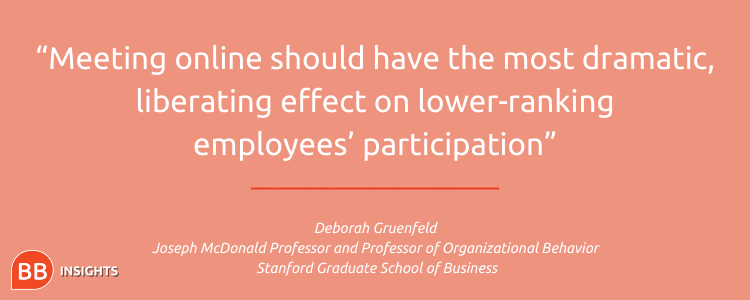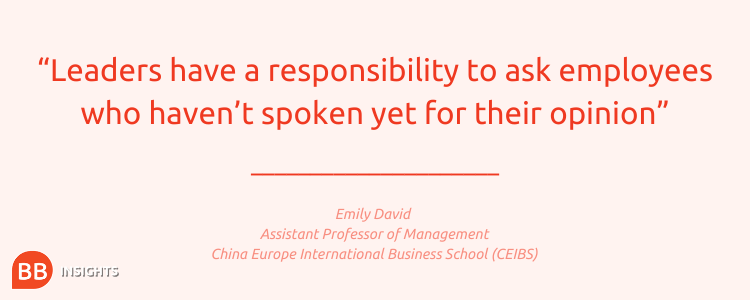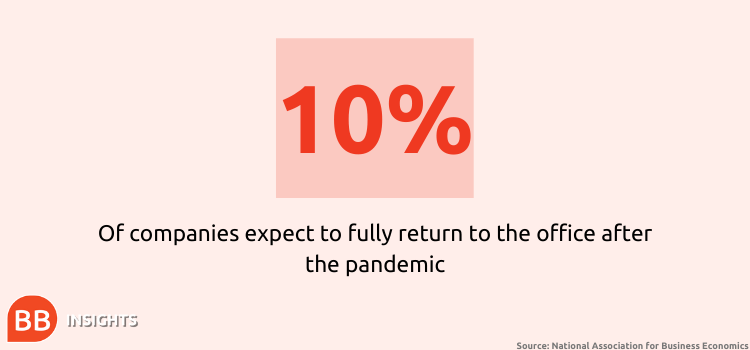Only 1 in 10 companies expect to fully return to the office after the pandemic, a new report from the National Association for Business Economics (NABE) suggests. As employees across the world continue to work from home, the impact of remote working on employee confidence and the power dynamics of the ‘office’ is emerging.
The impact of working from home on hierarchy
Deborah Gruenfeld (pictured right) is the Joseph McDonald professor and professor of organizational behavior at Stanford Graduate School of Business and the author of a new book, Acting with Power: Why We Are More Powerful Than We Believe.
She notes how the shift to working from home has highlighted the more subtle ways that power and hierarchies are reinforced in more traditional, in person work environments.
Higher-ranking group members tend to take up more space than lower-ranking employees—physically at their desk and by using more dramatic physical gestures. They speak more often in meetings and are more likely to interrupt peers.
But that hierarchy is absent in a virtual ‘office’. Employees working from home may feel more confident whilst engaging in video calls, for example: “In computer mediated exchanges of all kinds, we know that people are more likely to violate hierarchical norms,” Deborah explains.
“Because many of the cues we rely on to navigate these complex social situations are absent, we tend to be less sensitive to hierarchical differences.”
Noticed a difference in how you speak to your boss now you’re not in the office together? That’s expected, says Deborah.
A more even playing field is a good thing if it leads to less intimidation among lower-ranked employees and a boost in confidence. But there are pitfalls.
“It also creates a context in which it is easier to make a faux pas—to inadvertently offend a superior, or to fail to create a safe context for subordinates if leaders don’t actively re-assure others that they are in control,” Deborah explains.
Confidence can quickly vanish. Speaking out of turn online may have a longer lasting impact on employee spirit when working alone, leaving space for negative thoughts to permeate.

Paid to smile
Whilst leaders are more likely to interrupt others, lower-ranking team members tend to smile more.
“This is not because they’re happier,” says Deborah, “but because lower-ranking individuals are expected to make sure that no one else is ever uncomfortable.”
That can translate out of politeness into fewer interruptions on virtual meetings, which could be interpreted as a lack of contribution or confidence. That’s where managers need to utilize the available meeting tools. They could introduce something as simple as raising a hand or using in meeting chat functions to raise questions.
“Meeting online should have the most dramatic, liberating effect on lower-ranking employees’ participation,” says Deborah.
But while she sees some evidence of this occurring, she also believes that online meetings have activated new levels of social anxiety, caused by the stress of hierarchical contexts and the absence of social cues. It’s hard to read a room when you’re not in one together.
Don’t leave employees behind
As kitchens and bedrooms became offices employee bonding and comradeship changed dramatically. Emily David (pictured right), an assistant professor of management at China Europe International Business School (CEIBS), suggests team leaders should aim to pursue personal interactions while remote working continues.

Michael Segalla, a professor of management and human resources at HEC Paris, adds that creating virtual ‘water cooler’ exchanges should be prioritized and promoted. “More frequent virtual exchanges […] sends the message to employees that they are important and not forgotten.
“[Bosses] should also reach out directly to their colleagues by phone or video conference to ask questions, offer advice, or simply engage in the typical office banter that goes with a normal face to face work environment.”
There’s evidence this isn’t being implemented wholesale. Feelings of vulnerability have heighted since working from home began. A 2020 poll by the Kaiser Family Foundation, a health policy research organization, found that 53% of American adults have had their mental health negatively affected since the pandemic.
To combat this, Emily suggests leaders should attune themselves to employee emotions to improve communication.
“Creating and enforcing group communication norms like conversational turn-taking, not allowing peers to criticize others for going against the group consensus, and acknowledging when someone feels hurt or left out can go a long way to building trust and reduce status differences,” she asserts. “Companies should keep track of any differential adverse impact that they are seeing and try to mobilize resources to those most affected.”
Michael of HEC Paris (pictured right) suggests that a lack of face-to-face interaction has deprived employees of important psychological rewards, like validation and approval. “The lack of transparency has obscured important signals used to estimate power relationships,” he says.
A study Michael carried out last year showed that firms should be focusing on employee health and happiness during the pandemic rather than labor costs and customer experiences.
So, how can employers and team leaders navigate this? Michael suggests that by paying special attention to employees that appear disengaged, leaders can help mitigate the negatives.
In return, employees should offer “patience, understanding, and trust to their companies,” he says, “and should continue to deliver results on time.”

How to build confidence at home
From navigating new online communication tools to remote onboarding without meeting new colleagues, there are many new challenges to working from home that go beyond a simple lack of social interaction.
Traditional power indicators like height and posture bear little relevance when communicating through a screen. Whereas before employees may have had image insecurities, the shift online means the focus is often more on your speech.
Because of this, Emily says, “it can often be easier to feel confident in a virtual setting.” It just might take longer to get used to.

So, how can employees increase confidence when working from home?
The first step is to balance building a comfortable workspace with individual space restrictions and budgets. It’s vital for managers and leaders to assess whether their employees have been able to do this. Working from home won’t be the same for every employee.
Moving around—if you can—to freshen up the atmosphere can help you see your work with a fresh eye too. “Even buying an inexpensive ring light can help brighten your image and boost confidence,” suggests Emily.
Working from home means employees can be more prepared for meetings and use their notes to their advantage—setting up your notes for reference and motivational cues can give you the edge, thinks Emily.
The onus of confidence building also falls at the leader’s feet. “I think leaders also have a responsibility to ask employees who haven’t spoken yet for their opinion, and this inclusion will also help to boost their confidence and sense of belonging,” says Emily.
Adapting to working from home will require meeting challenges head on as and when they surface. There have been and will continue to be stumbling blocks for both leaders and their employees. Working from home is here to stay, and the changes to power dynamics in the virtual office shouldn’t leave anyone behind.
Read next:
How Working From Home Is Impacting Our Mental Health
BB Insights explores the latest research and trends from the business school classroom, drawing on the expertise of world-leading professors to inspire and inform current and future leaders
RECAPTHA :
9c
b7
d4
fb




 2
2 



Comments.